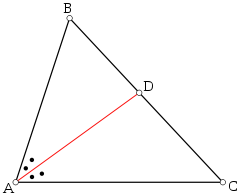Angle bisector theorem

In geometry, the angle bisector theorem is concerned with the relative lengths of the two segments that a triangle's side is divided into by a line that bisects the opposite angle. It equates their relative lengths to the relative lengths of the other two sides of the triangle.
Theorem
Consider a triangle ABC. Let the angle bisector of angle A intersect side BC at a point D between B and C. The angle bisector theorem states that the ratio of the length of the line segment BD to the length of segment DC is equal to the ratio of the length of side AB to the length of side AC:
and conversely, if a point D on the side BC of triangle ABC divides BC in the same ratio as the sides AB and AC, then AD is the angle bisector of angle ∠ A.
The generalized angle bisector theorem states that if D lies on the line BC, then
This reduces to the previous version if AD is the bisector of ∠ BAC. When D is external to the segment BC, directed line segments and directed angles must be used in the calculation.
The angle bisector theorem is commonly used when the angle bisectors and side lengths are known. It can be used in a calculation or in a proof.
An immediate consequence of the theorem is that the angle bisector of the vertex angle of an isosceles triangle will also bisect the opposite side.
Proofs
Proof 1
In the above diagram, use the law of sines on triangles ABD and ACD:
-
(1)
-
(2)
Angles ∠ BDA and ∠ ADC form a linear pair, that is, they are adjacent supplementary angles. Since supplementary angles have equal sines,
Angles ∠ BAD and ∠ DAC are equal. Therefore, the right hand sides of equations (1) and (2) are equal, so their left hand sides must also be equal.
which is the angle bisector theorem.
If angles ∠ BAD and ∠ DAC are unequal, equations (1) and (2) can be re-written as:
Angles ∠ BDA and ∠ ADC are still supplementary, so the right hand sides of these equations are still equal, so we obtain:
which rearranges to the "generalized" version of the theorem.
Proof 2

Let D be a point on the line BC, not equal to B or C and such that AD is not an altitude of triangle ABC.
Let B1 be the base (foot) of the altitude in the triangle ABD through B and let C1 be the base of the altitude in the triangle ACD through C. Then, if D is strictly between B and C, one and only one of B1 or C1 lies inside triangle ABC and we may assume without loss of generality that B1 does. This case is depicted in the adjacent diagram. If D lies outside of segment BC, then neither B1 nor C1 lies inside the triangle.
∠ DB1B and ∠ DC1C are right angles, while the angles ∠ B1DB and ∠ C1DC are congruent if D lies on the segment BC (that is, between B and C) and they are identical in the other cases being considered, so the triangles DB1B and DC1C are similar (AAA), which implies that
If D is the foot of an altitude, then,
and the generalized form follows.
History
The angle bisector theorem appears as Proposition 3 of Book VI in Euclid's Elements. According to Heath (1956), p. 197 (vol. 2), the corresponding statement for an external angle bisector was given by Robert Simson who claimed that Pappus assumed this result without proof. Heath goes on to say that Augustus De Morgan proposed that the two statements should be combined as follows:
- If an angle of a triangle is bisected internally or externally by a straight line which cuts the opposite side or the opposite side produced, the segments of that side will have the same ratio as the other sides of the triangle; and, if a side of a triangle be divided internally or externally so that its segments have the same ratio as the other sides of the triangle, the straight line drawn from the point of section to the angular point which is opposite to the first mentioned side will bisect the interior or exterior angle at that angular point.
References
- Heath, Thomas L. (1956). The Thirteen Books of Euclid's Elements (2nd ed. [Facsimile. Original publication: Cambridge University Press, 1925] ed.). New York: Dover Publications.
- (3 vols.): ISBN 0-486-60088-2 (vol. 1), ISBN 0-486-60089-0 (vol. 2), ISBN 0-486-60090-4 (vol. 3). Heath's authoritative translation plus extensive historical research and detailed commentary throughout the text.
Further reading
- G.W.I.S Amarasinghe: On the Standard Lengths of Angle Bisectors and the Angle Bisector Theorem, Global Journal of Advanced Research on Classical and Modern Geometries, Vol 01(01), pp. 15 – 27, 2012
External links
- A Property of Angle Bisectors at cut-the-knot
- Proof of angle bisector theorem at PlanetMath
- Another proof of angle bisector theorem at PlanetMath
- Intro to angle bisector theorem at Khan Academy